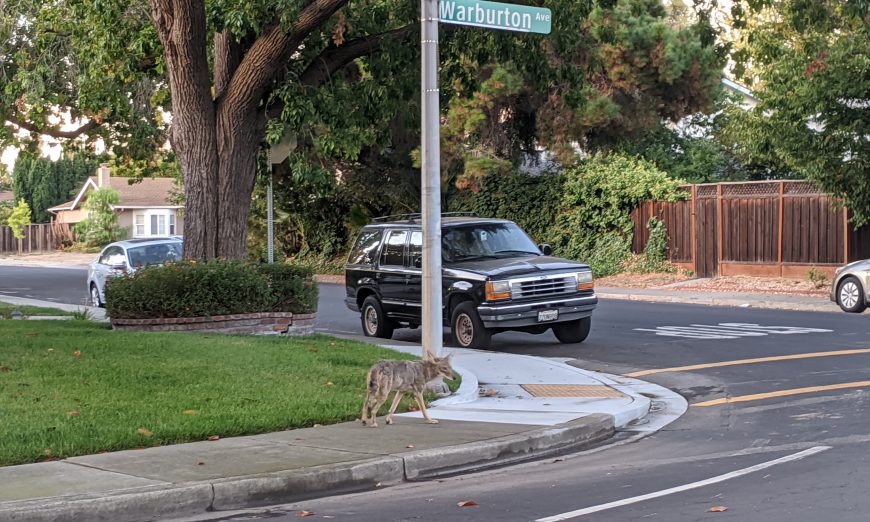It was about noon. Santa Clara resident Erik Bradley did a double take as he drove up to his home and got out of the car.
“Hey, isn’t that a coyote?” he called out across the street to his neighbor Gene Hall, who had just come home and gotten out of his own car.
As Bradley crossed the street to join Hall, the coyote trotted away from the men to the end of the block and turned onto Forbes Avenue, perhaps heading towards a nearby creek.
“I’ve been here 30-plus years, and it’s the first coyote I’ve seen around here,” said Hall, who lives on a block of one- and two-story homes.
“It was skinny and scraggily looking,” he continued, taking out his phone to show the photos he snapped.
Out of sight doesn’t mean out of town when it comes to coyotes, which are light grey/brown, weigh 20 – 30 pounds and are about a foot and a half tall. They have pointed ears and black-tipped, bushy tails that point down.
Since September, messages reporting and reacting to coyote sightings in other Santa Clara residential neighborhoods have been posted online on Nextdoor.
“It’s a relatively new, 21st-century phenomenon for coyotes to come back to urban areas,” said Jonathan Young, wildlife ecologist for Presidio Trust in San Francisco. “They’re in almost every urban area now. All they need are rats, gophers, water and a place to hide.
“People need to understand that they’re not going away. We need to promote coexistence and prevent conflict,” continued Young, who said that it’s illegal in California to kill coyotes.
Also, it’s illegal to trap and remove them from an area. Trap and release doesn’t even work. A released coyote either returns or is killed trying as it navigates traffic. Then a new coyote fills the void.
“Our behavior can drive or reduce conflict. Our behavior is important to making coyotes more shy of humans,” said Young. “A skinny coyote doesn’t mean it’s starving. It doesn’t need your help.”
The bulk of their diet is rodents, and eating a poisoned rat or mouse is a life threat for them and other wildlife that dine on rodents. However, coyotes are opportunistic eaters. They also eat fruit and small animals, including pet cats and dogs.
“Feeding these animals is really bad, either directly or indirectly with garbage, pet food left outside and fallen fruit,” said Young.
“Not feeding is huge. A fed coyote is a dead coyote,” Young continued. “Then it starts to associate people with food.”
While coyote attacks on adults are unusual, some have been bitten offering them food. Small children should always be attended. Aggressive coyotes are killed by wildlife authorities.
It’s important for coyotes to maintain their fear of humans. Hazing without harming is recommended to keep them out of neighborhoods. Be large and loud. Unlike raccoons, they will not stand their ground when hazed.
“The coyotes will catch on and move away,” said Young.
It was in 2002 that Coyotes returned to the 1,500-acre Presidio for the first time since about 1928. In 2016, Young monitored a young male with a GPS collar for a month as it journeyed south, then was killed on Highway 280 south of Los Gatos. The Presidio currently has four known coyotes.
“Managing coyotes will always be a challenge,” said Young. “They have an important role to play in the ecosystem, and they’re not going anywhere.”
Residents can report aggressive coyotes in Santa Clara to the Silicon Valley Animal Control Authority, (408) 764-0344. Vector Control (408) 918-4770 also provides information. In Sunnyvale, call Animal Control, (408) 730-7178.







The article reads that Jonathan Young of the Presidio Trust “said that it’s illegal in California to kill coyotes.” However, that is incorrect.
Coyotes may be taken at any time of the year, in any number (unless prohibited by local ordinance or otherwise) and in any manner except poison (California Code of Regulations, Title 14, sections 472 and 475).
Although it is legal to shoot a coyote, it is typically illegal to discharge a firearm within most city limits in California.